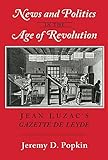News and Politics in the Age of Revolution : Jean Luzac's "Gazette de Leyde" / Jeremy D. Popkin.
Material type: TextPublisher: Ithaca, NY : Cornell University Press, [2015]Copyright date: ©2016Description: 1 online resource (312 p.) : 8 halftonesContent type:
TextPublisher: Ithaca, NY : Cornell University Press, [2015]Copyright date: ©2016Description: 1 online resource (312 p.) : 8 halftonesContent type: - 9781501701511
- 302.23/22/09409033 20
- online - DeGruyter
| Item type | Current library | Call number | URL | Status | Notes | Barcode | |
|---|---|---|---|---|---|---|---|
 eBook
eBook
|
Biblioteca "Angelicum" Pont. Univ. S.Tommaso d'Aquino Nuvola online | online - DeGruyter (Browse shelf(Opens below)) | Online access | Not for loan (Accesso limitato) | Accesso per gli utenti autorizzati / Access for authorized users | (dgr)9781501701511 |
Browsing Biblioteca "Angelicum" Pont. Univ. S.Tommaso d'Aquino shelves, Shelving location: Nuvola online Close shelf browser (Hides shelf browser)
Frontmatter -- Contents -- Preface -- Abbreviations -- 1. News and European Culture in the Eighteenth Century -- 2. The Environments of an Eighteenth-Century Newspaper -- 3. The Eighteenth-Century European Press -- 4. Making News'in the Eighteenth Century -- 5. Producing a Newspaper in the Eighteenth Century -- 6. The Gautte de Leyde‘s Readership -- 7. The Gazette de Leyde and the Crises of the 1770s -- 8. Engagement and Disillusionment: Jean Luzac and the Gautte de Leyde from 1782 to 1787 -- 9. The Challenge of the French Revolution -- 10 An Old Regime Gazette in the Revolutionary Maelstrom -- 11. The Gazztte de Leyde, Politics, and Journalism -- Sources and Bibliography -- Index
restricted access online access with authorization star
http://purl.org/coar/access_right/c_16ec
At the center of this book stands the story of a great but forgotten newspaper: the Gazette de Leyde, edited by Jean Luzac from 1772 to 1798. A French-language biweekly newspaper published in the Dutch city of Leiden from 1677 to 1811, the Gazette de Leyde was regarded as the international newspaper of record, occupying the cultural niche filled today by the New York Times and Le Monde.Jeremy D. Popkin reconstructs the Gazette's history, providing a comprehensive picture of the environment that produced it, how it gathered and printed its reports, its relationship with its readers, and the way it depicted the great events of three critical decades. In rich detail he shows that absolutist regimes often cooperated with the Gazette's editors, providing information and condoning its publication in open violation of their own censorship regimes.He also examines the Dutch context which fostered both the freedom that made the paper's publication possible and the technology and business skills that allowed for its rapid publication and successful marketing. In addition, he draws on a wide reading of the press of the period to compare the Gazette with other major newspapers. He concludes with a treatment of the paper's fortunes during the era of the French Revolution.
Mode of access: Internet via World Wide Web.
In English.
Description based on online resource; title from PDF title page (publisher's Web site, viewed 26. Apr 2024)









